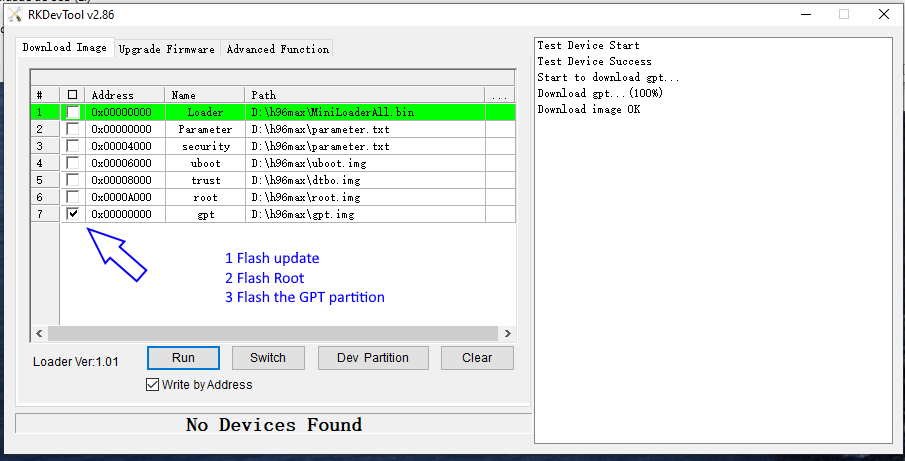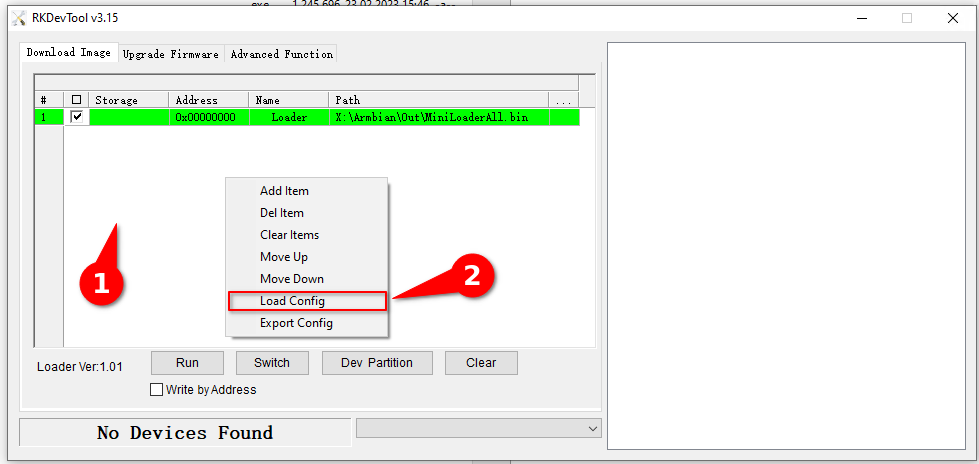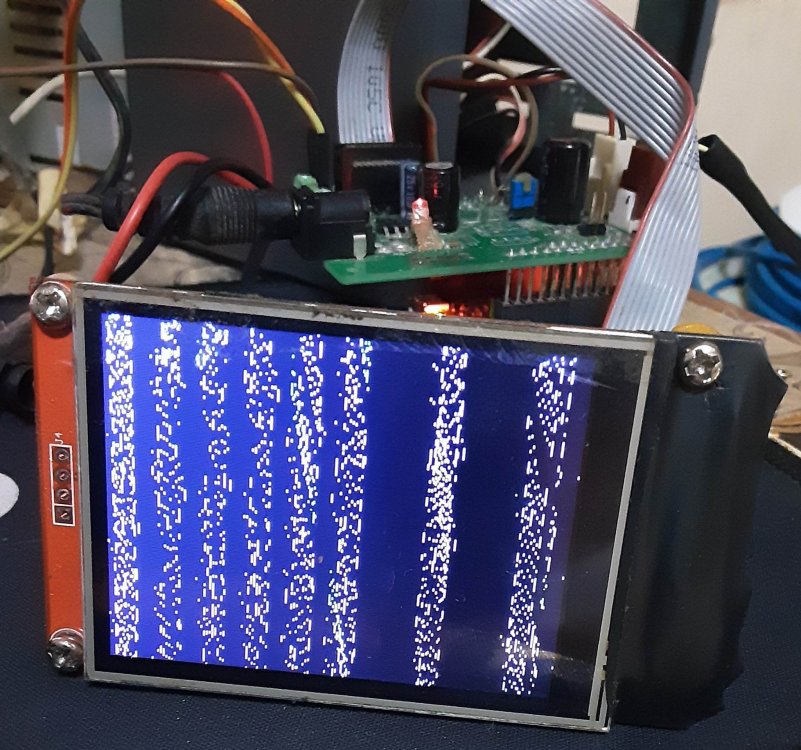Search the Community
Showing results for 'UUID does not exist'.
-

Efforts to develop firmware for HK1 RBOX R2 4G/64G
ewww replied to Hqnicolas's topic in Rockchip CPU Boxes
I have tried mainline uboot too, of course, there is no support, only evb-rk3568_defconfig here, I gave it a shot: with evb-rk3568_defconfig: no USB detected, although uboot shell detected emmc but I don't know why it can't find rootfs uuid on emmc, need some advice -

Efforts to develop firmware for HK1 RBOX R2 4G/64G
ewww replied to Hqnicolas's topic in Rockchip CPU Boxes
I'm using sdcard for storing /boot and emmc/usb for rootfs. here are steps for building rockchip uboot (refer to https://forum.pine64.org/showthread.php?tid=14507 ) git clone --depth=1 -b next-dev https://github.com/rockchip-linux/u-boot.git u-boot git clone --depth=1 https://github.com/rockchip-linux/rkbin.git rkbin cd u-boot ln -sf ../rkbin/bin/rk35/rk3568_bl31_v1.42.elf bl31.elf ln -sf ../rkbin/bin/rk35/rk3568_bl32_v2.09.bin tee.bin make rk3568_defconfig make -j4 && make -j4 u-boot.itb tools/mkimage -n rk3568 -T rksd -d ../rkbin/bin/rk35/rk3566_ddr_1056MHz_v1.16.bin:spl/u-boot-spl.bin idblock.bin # creating sdcard partitions: echo -e "\ng\nn\n1\n16384\n+16M\nt\n11\nn\n2\n\n+256M\nt\n2\n1\nn\n\n\n\nw" | fdisk /dev/mmcblk0 echo -e "\nx\nn\n1\nuboot\nr\nw" | fdisk /dev/mmcblk0 It will look like # we got u-boot.itb and idblock.bin now write sdcard dd if=idblock.bin of=/dev/mmcblk0 seek=64 dd if=u-boot.itb of=/dev/mmcblk0p1 mount armbian image and /dev/mmcblk0p2 then copy (armbian) /boot to /dev/mmcblk0p2, edit extlinux.conf, change uuid of rootfs to emmc/usb rootfs partition, copy working dtb and edit its path respectively. if you want to use sdcard only, so put armbian rootfs on /dev/mmcblk0p3, else delete /dev/mmcblk0p3 as you wish rk3568_bl31_v1.42.elf rk3568_bl32_v2.09.bin rk3566_ddr_1056MHz_v1.16.bin these file names may change whenever rockchip pushes their new version Boot log -
Hi, after having a hard time getting the ILI9341 touchscreen working with the NanoPi Neo (Allwinner H3) it seems to work now. To have more GPIOs available for other stuff the touch and display need to share SPI0 I would like to upload it to github because there is basically nothing out of the box available but I'm a total noob with NanoPi, Armbian and overlays so maybe someone could look at it. root@nanopineo:~# uname -a Linux nanopineo 5.15.93-sunxi #23.02.2 SMP Fri Feb 17 00:00:00 UTC 2023 armv7l armv7l armv7l GNU/Linux This is the wiring between ILI9341 and NanoPi Neo: /* 3.3v <--> VCC & LED GND <--> GND PC2 <--> SCK & T_CLK PC1 <--> SDO<MISO> & T_DO PC0 <--> SDI<MOSI> & T_DIN PA1 <--> DC PG8 <--> RESET PC3 <--> CS PA3 <--> T_CS PG9 <--> T_IRG */ This is the overlay: /dts-v1/; /plugin/; / { compatible = "allwinner,sun8i-h3"; fragment@0 { target = <&pio>; __overlay__ { spi0_cs1: spi0_cs1 { pins = "PC3"; function = "gpio_out"; output-high; }; spi1_cs1: spi1_cs1 { pins = "PA3"; function = "gpio_out"; output-high; }; opiz_display_pins: opiz_display_pins { pins = "PA1", "PG8", "PA6"; function = "gpio_out"; }; ads7846_pins: ads7846_pins { pins = "PG9"; function = "irq"; }; }; }; fragment@1 { target = <&spi1>; __overlay__ { pinctrl-names = "default", "default"; pinctrl-1 = <&spi1_cs1>; cs-gpios = <0>, <&pio 0 3 0>; /* PA3 */ }; }; fragment@2 { target = <&spi0>; __overlay__ { #address-cells = <1>; #size-cells = <0>; status = "okay"; pinctrl-names = "default", "default"; cs-gpios= <&pio 2 3 0>, <&pio 0 3 1>; opizdisplay: opiz-display@0 { pinctrl-1 = <&spi0_cs1>; reg = <0>; /* Chip Select 0 */ compatible = "ilitek,ili9341"; spi-max-frequency = <1000000>; status = "okay"; pinctrl-names = "default"; pinctrl-0 = <&opiz_display_pins>; rotate = <90>; bgr = <0>; fps = <33>; buswidth = <8>; dc-gpios = <&pio 0 1 0>; /* PIN_22 GPIOA1 > */ reset-gpios = <&pio 6 8 1 >; /* GPIOG8> */ /*led-gpios=<&pio 0 6 0>; PIN_12 GPIOA6 > */ debug=<4>; }; ads7846: ads7846@1 { reg = <1>; /* Chip Select 1 */ compatible = "ti,ads7846"; spi-max-frequency = <1000000>; status = "okay"; pinctrl-2=<&spi1_cs1 &spi1_cs1>; pinctrl-names = "default"; pinctrl-3 = <&ads7846_pins>; interrupt-parent = <&pio>; interrupts = <6 9 2>; /* PG9 IRQ_TYPE_EDGE_FALLING */ pendown-gpio = <&pio 6 9 0>; /* PG9 */ /* driver defaults, optional */ ti,x-min = /bits/ 16 <0>; ti,y-min = /bits/ 16 <0>; ti,x-max = /bits/ 16 <0x0FFF>; ti,y-max = /bits/ 16 <0x0FFF>; ti,pressure-min = /bits/ 16 <0>; ti,pressure-max = /bits/ 16 <0xFFFF>; ti,x-plate-ohms = /bits/ 16 <400>; }; }; }; }; This is the /boot/armbianEnv.txt verbosity=1 bootlogo=false console=serial disp_mode=1920x1080p60 overlay_prefix=sun8i-h3 overlays=usbhost1 usbhost2 spi0 param_spidev_spi_bus=0 param_spidev_spi_cs=1 param_spidev_spi_cs=0 rootdev=UUID=XYZ-LONG-UUID-IS-LONG rootfstype=ext4 user_overlays=ili-touch-spi usbstoragequirks=0x2537:0x1066:u,0x2537:0x1068:u After connecting via ssh and starting evtest it shows this when touched ( not sure if it shows the correct coordinates yet ) Event: time 1682020476.763295, -------------- SYN_REPORT ------------ Event: time 1682020476.775286, type 3 (EV_ABS), code 0 (ABS_X), value 535 Event: time 1682020476.775286, type 3 (EV_ABS), code 1 (ABS_Y), value 3553 Event: time 1682020476.775286, type 3 (EV_ABS), code 24 (ABS_PRESSURE), value 65169 So it looks like everything is working but to be on the safe side I would like to wait until some pro reviewed the overlay. Thanks.
-
Hi folks, perhaps you may help me... I use rclone from my Armbian box to access and to edit my Gemini capsule, the content is on a private Webdav directory my Email provider provides to me (it is not Boogle). The weird issue is that I can browse the remote resource with any file manager (TUI or GUI), I can open any file but I can't cd into... Gem ) ls extra/ gemlog/ pebcak/ root2.gmi fonts.txt graphics/ places/ root.gmi geminispace.txt index.gmi relog/ Gem ) cd gemlog cd: The directory “gemlog” does not exist Gem ) pwd /mnt/drive/Gem My Shell environment is Fish... Thanks 🙏 F.
-
hi everyone! try to start MCP2515 on Nano Pi Neo Air, have next success: Armbian 22.05.0-trunk Focal with Linux 5.15.33-sunxi root@nanopiair:~# dmesg | grep spi [ 1.965166] sun6i-spi 1c68000.spi: chipselect 0 already in use [ 1.965202] spi_master spi0: spi_device register error /soc/spi@1c68000/spidev@0 [ 1.965257] spi_master spi0: Failed to create SPI device for /soc/spi@1c68000/spidev@0 [ 1.965550] sun8i-h3-pinctrl 1c20800.pinctrl: pin PA15 already requested by 1c28c00.serial; cannot claim for 1c69000.spi [ 1.965580] sun8i-h3-pinctrl 1c20800.pinctrl: pin-15 (1c69000.spi) status -22 [ 1.965632] sun6i-spi 1c69000.spi: Error applying setting, reverse things back [ 13.173316] mcp251x spi0.0 can0: MCP2515 successfully initialized. root@nanopiair:~# dmesg | grep mcp [ 13.173316] mcp251x spi0.0 can0: MCP2515 successfully initialized. root@nanopiair:~# dmesg | fgrep -i can [ 1.965550] sun8i-h3-pinctrl 1c20800.pinctrl: pin PA15 already requested by 1c28c00.serial; cannot claim for 1c69000.spi [ 13.093230] CAN device driver interface [ 13.173316] mcp251x spi0.0 can0: MCP2515 successfully initialized. root@nanopiair:~# sudo ip link set can0 up type can bitrate 500000 root@nanopiair:~# ifconfig can0: flags=193<UP,RUNNING,NOARP> mtu 16 unspec 00-00-00-00-00-00-00-00-00-00-00-00-00-00-00-00 txqueuelen 10 (UNSPEC) RX packets 0 bytes 0 (0.0 B) RX errors 0 dropped 0 overruns 0 frame 0 TX packets 0 bytes 0 (0.0 B) TX errors 0 dropped 0 overruns 0 carrier 0 collisions 0 but can data doesnt receive and send to other device. this is my overlay /dts-v1/; /plugin/; / { compatible = "allwinner,sun8i-h3", "allwinner,sun50i-a64", "allwinner,sun50i-h5"; fragment@0 { target-path = "/clocks"; __overlay__ { #address-cells = <1>; #size-cells = <1>; can0_osc_fixed: can0_osc_fixed { compatible = "fixed-clock"; #clock-cells = <0>; clock-frequency = <40000000>; }; }; }; fragment@1 { target = <&pio>; __overlay__ { can0_pin_irq: can0_pin_irq { pins = "PA2"; function = "irq"; drive = <0x0>; pull = <0x1>; linux,phandle = <0x1>; phandle = <0x1>; }; }; }; fragment@2 { target = <&spi0>; __overlay__ { #address-cells = <1>; #size-cells = <0>; status = "okay"; mcp2515 { reg = <0>; compatible = "microchip,mcp2515"; pinctrl-names = "default"; pinctrl-0 = <&can0_pin_irq>; spi-max-frequency = <500000>; interrupt-parent = <&pio>; interrupts = <0 2 8>; clocks = <&can0_osc_fixed>; status = "okay"; }; }; }; }; this is my boot config verbosity=1 bootlogo=false console=serial disp_mode=1920x1080p60 overlay_prefix=sun8i-h3 overlays=i2c0 spi-spidev usbhost2 usbhost3 w1-gpio param_spidev_spi_bus=1 param_spidev_spi_cs=1 param_spidev_max_freq=1000000 rootdev=UUID=b159adca-200e-4061-b610-b41e2ca7e38e rootfstype=ext4 user_overlays=sun8i-h3-i2s0-master spi-mcp251x usbstoragequirks=0x2537:0x1066:u,0x2537:0x1068:u try to test loopback: sudo ip link set can0 type can loopback on cansend can0 001#1122334455667788 but command candump can0 doesnt anwer me, just hold it tty. only CTRL+C breacked it. Please help me to dig and solve problem.
-
Hi, i have armbian bullseye (headless) installed on my odroid-hc4. petitboot is disabled. The boot-partition lies on a sd-card while the root-partion is on a ssd. this configuration worked fine. After upgrading to armbian bullseye 22.11 the boot process stucks in initramfs cause the root file-system is not found anymore (ALERT! UUID=xxx does not exist. Dropping to a shell. The sd-card with the boot partition as well as the ssd with the root-partition can be mounted on another PC and seem to be flawless. the UUID shown in fstab and initramfs are identical. In initramfs ls /dev/sd* shows no devices while ls /dev/mm* shows the sdcard (mmcblk01...). I don't really know how the boot process works on an arm-system. What steps can I do to narrow down the problem. Thanks in advance. Hardware: odroid-hc4, samsung 870 EVO 1TB (sda), WD60EFZX (sdb), BS: armbian-bullseye with OMV 6.0.46-5 fs: ext4 no raid
-
Yesterday 1 of my 3 NanoPi Neo2 didnt boot complete anymore. Because I had i the last time - I thought that the internal 2.5" HDD has died and couldnt mounted anymore from /etc/fstab Today I checked the 2.5" HDD externally and its fine So I connected a TTL-RS232 for the boot-output and did get: Begin: Running /scripts/local-block ... done. Begin: Running /scripts/local-block ... done. Begin: Running /scripts/local-block ... done. Begin: Running /scripts/local-block ... done. Begin: Running /scripts/local-block ... done. done. Gave up waiting for root file system device. Common problems: - Boot args (cat /proc/cmdline) - Check rootdelay= (did the system wait long enough?) - Missing modules (cat /proc/modules; ls /dev) ALERT! UUID=47f29e2a-b4bd-451d-88 does not exist. Dropping to a shell! (initramfs) The NanoPi Neo2 isnt finding the UUID for the root-filesystem = my sdcard? I did pu the card in a reader on my other NanoPi Neo2 and used blkid to check the UUID - and did get: /dev/sdb1: UUID="47f29e2a-b4bd-451d-88a9-35998f669cd1" TYPE="ext4" PARTUUID="53e18e13-01" in /etc/fstab there is UUID=47f29e2a-b4bd-451d-88 and here at the "remote" system UUID=47f29e2a-b4bd-451d-88a9-35998f669cd1 Why and when has this UUID extended/expanded (and why isnt it booting with the short version?)? So I did put the new/longer UUID for root in the /etc/fstab on the sdcard and put it back in the half-booting NanoPi Neo2. armbianmonitor -u System diagnosis information has been uploaded to http://ix.io/2KOz Now this Neo2 is booting fine. Should I check my other 2 Neo2 and compare blkid to the /etc/fstab ? On my second (512MB) Neo2 I got the same long UUID for root: UUID=47f29e2a-b4bd-451d-88a9-35998f669cd1 / ext4 defaults,noatime,nodiratime,commit=600,errors=remount-ro 0 1 /dev/mmcblk0p1: UUID="47f29e2a-b4bd-451d-88a9-35998f669cd1" TYPE="ext4" PARTUUID="53e18e13-01" but on my third (1GB LTS) Neo2 the UUIDs didnt match and it DOES boot and mount root: UUID=47f29e2a-b4bd-451d-88a9-35998f669cd1 / ext4 defaults,noatime,nodiratime,commit=600,errors=remount-ro 0 1 /dev/mmcblk0p1: UUID="4e972167-ea53-4c61-9d49-a67b1f839f5f" TYPE="ext4" PARTUUID="d2f285f3-01" [EDIT] edited /etc/fstab to 4e972167-ea53-4c61-9d49-a67b1f839f5f as seen in blkid and it boots also perfect (maybe a differnt u-boot in "flash"?) System diagnosis information has been uploaded to http://ix.io/2KON Is it normal that all 3 Neo2 got 47f29e2a-b4bd-451d-88a9-35998f669cd1 as root-UUID? (UUID of the flash image - should this change after resize?) The 1GB Neo2 does use a Focal-dev-image and the other use a Buster-dev-image.
-

Efforts to develop firmware for H96 MAX V56 RK3566 4G/32G
Hqnicolas replied to Hqnicolas's topic in Rockchip CPU Boxes
🏆 help to add other boards in armbian standart, you don't need to be a programmer to help the community, just need a copy of the ARM BOARD and a x86 computer to compile new versions. If you like what you see here and want to help: Donate Armbian, the like button only costs a few dollars. Armbian Needs you help! ####################### Just a Few clicks to help ################## This is an internal mmc trick 2-step image! You no longer need to solder an SD-card Reader like the creepy Release Version v0.5 BETA that i made. check before if your device has the regulator: fan53555 check before if your device has: tcs4525 check before if your device has: RK809-5 works with 4gb and 8gb devices How to use it: - install RKDevTool Drivers Rockchip - Use RkDevTool v2.86 - Drop Config.cfg the RkDevTool config file on folder Righ click on white background from RKDevTool click on Load Config Select the Config.cfg Step 1: Armbian 23.11 Kernel 6.2 H96 MAX 4GB/32GB Rk3566 Server unofficial Armbian 23.11 Kernel 6.2 H96 MAX 8GB/64GB Rk3566 Server unofficial Extract this file.xz with 7zip Extract this file.tar with 7zip Connect Your device: How? press the back button with a toothpick and connect male to male USB to you computer. Flash the Update Image on entire device as an Upgrade Firmware After Complete ! ! Disconect your device ! ! Step 2: Reconnect Your device: How? press the back button with a toothpick and connect male to male USB to you computer. Flash the GPT image inside the MMC GPT partition how: on RkDevTool v2.86 double click the number on table set Address on 0x00000000 set Name on gpt select the root file to flash on the "..." the dot right side of the table........ mark, Write by address after flash, it's done, use HDMI and USB to create user and password, regular armbian install... The Gpt file The Server 4gb Update image The Server 8gb Update image Yes, you can Skip Root flash. But you can drop the v0.7 Root.img file. Please Reflash GPT.img after new Root.img Debian 12 BookWorm Server Minimal ROOT ##################################### END ############################################## ############################### HOT TO CREATE IMAGES ##################################### if you wanna do all that creepy again with other devices and images, (please do it on other devices) and topic this is all you need to create this image, first step: Compile armbian on linux desktop dont forgot to do it with modified DTS file: in this case DTB + DTS Files for you to edit because you want to help the community any resemblance to this topic is mere adaptation Mount that image virtual device like /media/armbian_boot fdisk -l your-armbian-image-for-sd-card.img mount -o loop your-armbian-image-for-sd-card.img /media/armbian_boot if you can't "like WSL2" sudo apt-get install kpartx sudo kpartx -av your-armbian-image-for-sd-card.img sudo mount -o loop /dev/mapper/loop0p1 /media/armbian_boot Second Step: prepare an sd card or usb flash dummy , can be anithing with 6gb fdisk /dev/mmcblk1 N default default (lower this value to match the size of your root image) T 1 W third step: format that flash drive for ext4 mkfs.ext4 /dev/mmcblk1p1 fourth step: mount that clear partition and copy the entire virtual drive to the flash device mount /dev/mmcblk1p1 /mnt/ rsync -avx /media/armbian_boot/ /mnt/ fifth Step: Edit your uuid From Armbian Boot config "uuid for /dev/mmcblk1p1" blkid nano -w /mnt/boot/extlinux/extlinux.conf sync umount /mnt sixth step: make an hardware RAW.img from hardware flash drive with these parameters sudo dd if=/dev/mmcblk1p1 of=~/root.img bs=4096 status=progress PS: can be /dev/SDA" I do it on my h96max" so it's mmcblk1 If you want a GPT.img backup dd if=/dev/mmcblk1 of=gpt.img bs=16896 count=1 dd if=/dev/mmcblk1p1 of=gpt1.img bs=16896 count=1 dd if=/dev/mmcblk1p2 of=gpt2.img bs=16896 count=1 now you have an ROOT IMAGE MADE BY YOURSELF! Update.img CREATE the Update Image on linux with the rockchip software. Linux Pack Rockchip Firmware ./mkupdate.sh Uboot Legacy, Parameter.txt to create the Rockchip image this process generate two files: File1: Linux_Pack_Firmware/rockdev/Image/update.img File2: Linux_Pack_Firmware/rockdev/update.img I generally use the File2 to flash my device on upgrade Firmware RKDevTool open new topics when performing this procedure on a device other than the H96MAX I will be happy to help This topic is Closed until Kernel 7 i dont wanna talk about RK3566 for the rest of my short life thanks to the armbian community for 42U$ now i have a docker service with kernel 6.2 gigabit network and how many hard drives i can connect to the usb hub we're running it "Cuban internet style" with 42U$ computers to escape government censorship. i laughed at china, now it happens here in latin america. -

Tanix TX3 Mini (Amlogic S905W) Broadcom WiFi issue
Clonazepunk replied to Clonazepunk's topic in General Chat
Ok, i'm stupid The firmware for this board is missing. [ 9.020401] brcmfmac mmc2:0001:1: Direct firmware load for brcm/brcmfmac4330-sdio.amlogic,p281.bin failed with error -2 [ 9.020401] brcmfmac mmc2:0001:1: Direct firmware load for brcm/brcmfmac4330-sdio.amlogic,p281.bin failed with error -2 the file brcmfmac4330-sdio.amlogic,p281.bin simply doesn't exist Wonder if it works if i borrow it from Android... EDIT: Found a workaround! I'll leave this thread for other user's further research cp /usr/lib/firmware/brcm/brcmfmac4330-sdio.bin /usr/lib/firmware/brcm/brcmfmac4330-sdio.amlogic,p281.bin For some reason, the kernel won't use the default firmware, and want the specific board version. It works now! -
https://armbian.atlassian.net/browse/AR-1001 added function to unmount and format MTD flash added menu entry for said function. added form mtd Jira reference number AR-1001 How Has This Been Tested? added nandsim and virtulied the MTD. https://gist.github.com/Tearran/e704f04a6fbc457a56dc5f5f87f8899d created a virtual MTD mounted /temp/boot created a file to erace Unmounted then remounted to confirm file still exist ran mtd-tools format confirmed no data remained created function and ran with same results Checklist: [?] My code follows the style guidelines of this project [*] I have performed a self-review of my own code [?] I have commented my code, particularly in hard-to-understand areas [NO ] I have made corresponding changes to the documentation [?] My changes generate no new warnings [?] Any dependent changes have been merged and published in downstream modules View the full article
-
I have a development board, model eaidk-310, with soc rk3228h (which is said to be the same as rk3328). The official website of the board has been closed, so I cannot obtain more related information. However, I found the official firmware and can use rockchip's official tool for burning. The file structure is as follows. 190798 Jun 8 2020 MiniLoaderAll.bin 33554432 Jun 8 2020 boot_linux.img 374 Jun 8 2020 parameter-linux.txt 6815744000 Jun 8 2020 rootfs.img 4194304 Jun 8 2020 trust.img 4194304 Jun 8 2020 uboot.img parameter-linux.txt is: FIRMWARE_VER:8.1 MACHINE_MODEL:RK3328 MACHINE_ID:007 MANUFACTURER:Rockchip MAGIC: 0x5041524B ATAG: 0x00200800 MACHINE: 3328 CHECK_MASK: 0x80 PWR_HLD: 0,0,A,0,1 TYPE: GPT CMDLINE:mtdparts=rk29xxnand:0x00002000@0x00002000(uboot),0x00002000@0x00004000(trust),0x00010000@0x00006000(boot_linux:bootable),-@0x00016000(rootfs:grow) uuid:rootfs=614e0000-0000-4b53-8000-1d28000054a9 I tried to install armbian's image based on rk3328, which is officially supported. Some of them can boot up but neither network nor Bluetooth works properly. Therefore, I want to compile my own version to support these peripherals. My question is whether I can use the pre-compiled .img files in these official images to compile my own armbian? If possible, how should I configure ./compile.sh? Thank you all. Translated from:
-
At Raspberry Pi (at least on R.Pi 4) it is possibility to set up more than one 1-wire bus. Can that be done on Orange Pi plus 2e with Armbian? uname -a Linux XXXXXXXXXXX 5.15.93-sunxi #23.02.2 SMP Fri Feb 17 23:49:46 UTC 2023 armv7l armv7l armv7l GNU/Linux /boot/armbianEnv.txt verbosity=1 bootlogo=false console=both disp_mode=1920x1080p60 overlay_prefix=sun8i-h3 rootdev=UUID=d908a8da-8d2e-4802-8a05-aaab4f3290bb rootfstype=ext4 overlays=w1-gpio param_w1_pin=PD14 param_w1_pin_int_pullup=0 usbstoragequirks=0x2537:0x1066:u,0x2537:0x1068:u If it is possible: Any tip on configuration will make me happy. And can it be internal pull up for all 1-wire interfaces?
-
Hello guys, i'm trying to connect that ili9341 display with my m2 zero but it wont work. My armbian Version: Armbian_23-02-0-trunk_Bananapim2zero_lunar_edge_6.1.11_xfce_desktop The display has a pinout that matches with the raspberry pi, so also the banana pi m2 zero would do the job, since it has the same pinout like the raspberry pi has. It uses 26 pins to connect to the banana pi m2 zero gpio output pins. 3 buttons and a touch panel are available but i only want to use the lcd for now. I edited the armbianEnv.txt to open the spi port and added my overlay tft.dts to /boot/overlay-user but i cant get a picture on the screen, Its just glowing white. Am I missing something? Are my gpios numbers in the overlay correct? do i have to install additional software? I would be very happy for tips or help! My armbianEnv.txt : verbosity=1 bootlogo=false console=both disp_mode=1920x1080p60 overlay_prefix=sun8i-h3 rootdev=UUID=39f6ab06-e14f-4885-8454-717c5405f006 rootfstype=ext4 overlays=cpu-clock-1.2GHz-1.3v spi-spidev param_spidev_spi_bus=0 user_overlays=tft usbstoragequirks=0x2537:0x1066:u,0x2537:0x1068:u My overlay tft.dts /dts-v1/; /plugin/; / { compatible = "allwinner,sun4i-a10", "allwinner,sun7i-a20", "allwinner,sun8i-h3", "allwinner,sun50i-a64", "allwinner,sun50i-h5"; fragmen@0 { target = <&pio>; __overlay__ { display_pins: display_pins { pins = "PC0", "PC3"; function = "gpio_out"; }; }; }; fragment@1 { target = <&spi0>; __overlay__ { /* needed to avoid dtc warning */ #address-cells = <1>; #size-cells = <0>; display: display@0 { compatible = "adafruit,yx240qv29", "ilitek,ili9341"; reg = <0>; pinctrl-names = "default"; pinctrl-0 = <&display_pins>; spi-max-frequency = <16000000>; rotation= <270>; bgr; fps = <10>; buswidth = <8>; height = <240>; width = <320>; reset-gpios = <&pio 0 25 0>; /* GPIOA 6 */ dc-gpios = <&pio 0 24 0>; /* GPIOA 3 */ debug = <3>; }; }; }; __overrides__ { rotation = <&display>, "rotation:0"; fps = <&display>, "fps:0"; debug = <&display>, "debug:0"; }; };
-
Hi, I finally have time to get back to my little project. I've been trying to get a working display with tinydrm for an ILI9341 base lcd. My setup works on OpenWrt with the older fbtft driver, but now I'd like to go back and try Armbian (current release is Jammy) on it. My first try with devicetree overlay seems functional but not correct. The display just show garbled data (see attached). What could be the problem with it? This is my env. verbosity=1 bootlogo=false console=both overlay_prefix=sun50i-h5 overlays=usbhost1 usbhost2 spi-spidev param_spidev_spi_bus=0 rootdev=UUID=e0ed80c4-a252-4d96-ad61-78b7834d6b8d rootfstype=ext4 user_overlays=spilcd usbstoragequirks=0x2537:0x1066:u,0x2537:0x1068:u and this is my overlay /dts-v1/; /plugin/; / { compatible = "allwinner,sun4i-a10", "allwinner,sun7i-a20", "allwinner,sun8i-h3", "allwinner,sun50i-a64", "allwinner,sun50i-h5"; fragment@0 { target = <&spi0>; __overlay__ { #address-cells = <1>; #size-cells = <0>; display: display@0 { compatible = "adafruit,yx240qv29", "ilitek,ili9341"; reg = <0>; rotation = <270>; reset-gpios = <&pio 0 6 0>; /* GPIOA 6 */ dc-gpios = <&pio 0 3 0>; /* GPIOA 3 */ }; }; }; };
-
I have an issue with NVMe booting after following this guide and installing this image: Armbian_23.5.1_Rock-5b_jammy_legacy_5.10.160.img.xz The Rock 5B SBC now boots correctly only about 30% of the time: Begin: Mounting root file system ... Begin: Running /scripts/local-top ... done. Begin: Running /scripts/local-premount ... Scanning for Btrfs filesystems done. Begin: Will now check root file system ... fsck from util-linux 2.37.2 [/usr/sbin/fsck.ext4 (1) -- /dev/nvme0n1p1] fsck.ext4 -a -C0 /dev/nvme0n1p1 /dev/nvme0n1p1: clean, 46623/3276800 files, 906832/13107200 blocks done. done. Begin: Running /scripts/local-bottom ... done. Begin: Running /scripts/init-bottom ... done. and when it fails, it does so with this error message: Begin: Mounting root file system ... Begin: Running /scripts/local-top ... done. Begin: Running /scripts/local-premount ... Scanning for Btrfs filesystems done. Begin: Waiting for root file system ... Begin: Running /scripts/local-block ... done. done. Gave up waiting for root file system device. Common problems: - Boot args (cat /proc/cmdline) - Check rootdelay= (did the system wait long enough?) - Missing modules (cat /proc/modules; ls /dev) ALERT! /dev/mmcblk0p1 does not exist. Dropping to a shell! Is anyone else having the same behavior? Could it be the power supply even if no boot loop is actually occurring? My NVMe is a 1TB Samsung 980 Pro. Thx.
-
The debug console output of the failed loading of Armbian_23.08.0-trunk_Orangepi5-plus_jammy_legacy_5.10.160_gnome_desktop is as below: ... U-Boot 2017.09-armbian (May 31 2023 - 17:58:42 +0000) Model: RK3588 Orange Pi 5 Plus PreSerial: 2, raw, 0xfeb50000 DRAM: 15.7 GiB Sysmem: init Relocation Offset: eda65000 Relocation fdt: eb9f9a98 - eb9fecc8 CR: M/C/I Using default environment mmc@fe2c0000: 0, mmc@fe2e0000: 1 Bootdev(atags): mmc 0 MMC0: Legacy, 52Mhz PartType: EFI DM: v2 boot mode: None Model: RK3588 Orange Pi 5 Plus CLK: (sync kernel. arm: enter 1008000 KHz, init 1008000 KHz, kernel 0N/A) b0pll 24000 KHz b1pll 24000 KHz lpll 24000 KHz v0pll 24000 KHz aupll 24000 KHz cpll 1500000 KHz gpll 1188000 KHz npll 24000 KHz ppll 1100000 KHz aclk_center_root 702000 KHz pclk_center_root 100000 KHz hclk_center_root 396000 KHz aclk_center_low_root 500000 KHz aclk_top_root 750000 KHz pclk_top_root 100000 KHz aclk_low_top_root 396000 KHz Net: No ethernet found. Hit key to stop autoboot('CTRL+C'): 0 switch to partitions #0, OK mmc0 is current device mmc@fe2c0000: 0 (SD) mmc@fe2e0000: 1 switch to partitions #0, OK mmc0 is current device Scanning mmc 0:1... Found U-Boot script /boot.scr reading /boot.scr 3476 bytes read in 2 ms (1.7 MiB/s) ## Executing script at 00500000 Boot script loaded from mmc 0 reading /armbianEnv.txt 172 bytes read in 1 ms (168 KiB/s) reading /uInitrd 15256294 bytes read in 1224 ms (11.9 MiB/s) reading /Image 34638336 bytes read in 2775 ms (11.9 MiB/s) reading /dtb/rockchip/rk3588-orangepi-5-plus.dtb 265256 bytes read in 31 ms (8.2 MiB/s) ** Unable to read file /dtb/rockchip/overlay/rockchip-rk3588-fixup.scr ** Unknown command 'kaslrseed' - try 'help' Fdt Ramdisk skip relocation ## Loading init Ramdisk from Legacy Image at 0a200000 ... Image Name: uInitrd Image Type: AArch64 Linux RAMDisk Image (gzip compressed) Data Size: 15256230 Bytes = 14.5 MiB Load Address: 00000000 Entry Point: 00000000 Verifying Checksum ... OK ## Flattened Device Tree blob at 0x0a100000 Booting using the fdt blob at 0x0a100000 reserving fdt memory region: addr=a100000 size=a7000 'reserved-memory' cma: addr=10000000 size=10000000 'reserved-memory' ramoops@110000: addr=110000 size=f0000 Using Device Tree in place at 000000000a100000, end 000000000a1a9fff Adding bank: 0x00200000 - 0xf0000000 (size: 0xefe00000) Adding bank: 0x100000000 - 0x3fc000000 (size: 0x2fc000000) Adding bank: 0x3fc500000 - 0x3fff00000 (size: 0x03a00000) Total: 4644.846 ms Starting kernel ... [2J[3J[-1;-1fdone. Begin: Mounting root file system ... Begin: Running /scripts/local-top ... done. Begin: Running /scripts/local-premount ... Scanning for Btrfs filesystems done. Begin: Waiting for root file system ... Begin: Running /scripts/local-block ... done. done. Gave up waiting for root file system device. Common problems: - Boot args (cat /proc/cmdline) - Check rootdelay= (did the system wait long enough?) - Missing modules (cat /proc/modules; ls /dev) ALERT! PARTUUID=614e0000-0000 does not exist. Dropping to a shell!
-
Hello all, I am trying to interface with the MCP2515 on SPI2 of the RockPi4B on Armbian 22.08.6 Bullseye with Linux 5.15.74-rockchip64 and encountering some issues. The rockpi4B pins that I am using to connect to the MCP2515 INT - GPIO2_A7 MOSI - GPIO2_B2 MISO - GPIO2_B1 CLK - GPIO2_B3 CS - GPIO2_B4 When using the overlay file that I have shown below, the output for "dmesg | grep mcp": [ 6.662536] rockchip-pinctrl pinctrl: unable to find group for node mcp2515_int_pin I have been able to get the MCP2515 to initialize successfully, but only if I comment out the pinctrl-0 reference to the mcp2515_int_pin in the overlay. Doing this I can bring up the device but I am only able to send/receive a few messages before candump shows it's not transmitting any messages until I bring down and up the can0 device where it will do the same thing. The interesting thing is, when the device doesn't communicate I can still see that the can0 device is still in the "Error-Active" mode, so theoretically I should still be able to interface with it. So, I am led to believe the issue I am encountering is due to that comment line to pinctrl-0 in the overlay. Just not sure of the solution to this. I have looked about just about every forum that makes reference to the MCP2515 and have not found any promising solutions. I have tried changing the target on fragment@0 to <&gpio>, <&gpio2>, etc. Here is a look at the DTS overlay I am using for the MCP2515: //This devicetree overlay is used for RS485 CAN HAT. /dts-v1/; /plugin/; / { compatible = "rockchip,rockpi","rockchip,rk3399", "rockchip,rk3399-pinctrl"; fragment@0 { target = <&pinctrl>; __overlay__ { mcp2515_int_pin: mcp2515_int_pin { rockchip,pins = <2 7 0 &pcfg_pull_none>; }; }; }; fragment@1 { target-path = "/"; __overlay__ { can_mcp2515_osc: can-mcp2515-osc { compatible = "fixed-clock"; clock-frequency = <16000000>; #clock-cells = <0>; }; }; }; fragment@2 { target = <&spi2>; __overlay__ { status = "okay"; max-freq = <10000000>; #address-cells = <1>; #size-cells = <0>; can_mcp2515: can-mcp2515@0 { status = "okay"; compatible = "microchip,mcp2515"; reg = <0>; interrupt-parent = <&gpio2>; interrupts = <7 2 8>; spi-max-frequency = <10000000>; clocks = <&can_mcp2515_osc>; vdd-supply = <&vcc3v3_sys>; xceiver-supply = <&vcc3v3_sys>; pinctrl-names = "default"; pinctrl-0 = <&mcp2515_int_pin>; }; }; }; }; And my armbianEnv.txt: verbosity=1 bootlogo=false overlay_prefix=rockchip fdtfile=rockchip/rk3399-rock-pi-4b.dtb rootdev=UUID=fa2cbc7c-56d1-448b-9ab3-fe864e21fbc5 rootfstype=ext4 overlays=spi-spidev param_spidev_spi_bus=1 user_overlays=spi1-mcp2515-can0-overlay usbstoragequirks=0x2537:0x1066:u,0x2537:0x1068:u Here's a link to my armbianmonitor -u: https://paste.armbian.com/azameworos I would like to mention I not very skilled with Linux based devices so please bear with me. Any help would be greatly appreciated! Best, Austin
-

Efforts to develop firmware for H96 MAX V56 RK3566 4G/32G
Hqnicolas replied to Hqnicolas's topic in Rockchip CPU Boxes
dear friends that buy cheap 42U$ tv boxes on chinese scam sites! rk3566 h96MAX ARMBIAN23 kernel6 MMC image it's done. 🏆 help to add other boards in armbian standart, you don't need to be a programmer to help the community, just need a copy of the ARM BOARD and a x86 computer to compile new versions. This is an internal mmc trick 2-step image! You no longer need to solder an SD-card Reader like the creepy Release Version v0.5 BETA that i made. check before if your device has the regulator: fan53555 check before if your device has: tcs4525 check before if your device has: RK809-5 works with 4gb and 8gb devices How to use it: - install RKDevTool Drivers Rockchip - Use RkDevTool v2.86 - Drop Config.cfg the RkDevTool config file on folder Righ click on white background from RKDevTool click on Load Config Select the Config.cfg Step 1: Armbian 23.11 Kernel 6.2 H96 MAX 4GB/32GB Rk3566 Server.img Armbian 23.11 Kernel 6.2 H96 MAX 8GB/64GB Rk3566 Server.img Extract this file.xz with 7zip Extract this file.tar with 7zip Connect Your device: How? press the back button with a toothpick and connect male to male USB to you computer. Flash the Update Image on entire device as an Upgrade Firmware After Complete ! ! Disconect your device ! ! and because I'm lazy and I don't want to work on that damn FIT image anymore. You will need to do a second step: Step 2: Reconnect Your device: How? press the back button with a toothpick and connect male to male USB to you computer. Flash the armbian extracted GPT image inside the MMC gpt partition how: on RkDevTool v2.86 double click the number on table set Address on 0x00000000 set Name on gpt select the root file to flash on the "..." the dot right side of the table........ mark, Write by address after flash, it's done, use HDMI and USB to create user and password, regular armbian install... The Gpt file The Server 4gb Update image The Server 8gb Update image Yes, you can Skip Root flash. But you can drop the v0.7 Root.img file. Please Reflash GPT.img after new Root.img Two Root v0.7 Files: Debian 12 BookWorm Server Minimal ROOT Debian 12 BookWorm Desktop Gnome ROOT Armbian_23.11.0-trunk_Station-m2_jammy_edge_6.2.16_Server_Minimal.img ✔️ Boot from internal MMC ✔️ Runs kernel 6.2 Server ✔️ display video HDMi ✔️ detect internal MMC ✔️ Detect SD-CARD ✔️ Detect USB 2.0 port ✖️ (no USB2.0 on Server Images) Detect USB 3.0 port ✔️ (use a cheap usb hub 3.0) ##################################### END ############################################## ############################### HOT TO CREATE IMAGES ###################################### if you wanna do all that creepy again with other devices and images, (please do it on other devices) and topic this is all you need to create this image, first step: Compile armbian on linux desktop dont forgot to do it with modified DTS file: in this case DTB + DTS Files for you to edit because you want to help the community any resemblance to this topic is mere adaptation Mount that image virtual device like /media/armbian_boot fdisk -l your-armbian-image-for-sd-card.img mount -o loop your-armbian-image-for-sd-card.img /media/armbian_boot if you can't "like WSL2" sudo apt-get install kpartx sudo kpartx -av your-armbian-image-for-sd-card.img sudo mount -o loop /dev/mapper/loop0p1 /media/armbian_boot Second Step: prepare an sd card or usb flash dummy , can be anithing with 6gb fdisk /dev/mmcblk1 N default default (lower this value to match the size of your root image) T 1 W third step: format that flash drive for ext4 mkfs.ext4 /dev/mmcblk1p1 fourth step: mount that clear partition and copy the entire virtual drive to the flash device mount /dev/mmcblk1p1 /mnt rsync -avx --timeout=10 /media/armbian_boot/ /mnt/ fifth Step: Edit your uuid From Armbian Boot config "uuid for /dev/mmcblk1p1" blkid nano -w /mnt/boot/extlinux/extlinux.conf sync umount /mnt sixth step: make an hardware RAW.img from hardware flash drive with these parameters sudo dd if=/dev/mmcblk1p1 of=~/root.img bs=4096 status=progress PS: can be /dev/SDA" I do it on my h96max" so it's mmcblk1 now you have an ROOT IMAGE MADE BY YOURSELF! Update.img CREATE the Update Image on linux with the rockchip software. Linux Pack Rockchip Firmware ./mkupdate.sh Uboot Legacy, Parameter.txt to create the Rockchip image this process generate two files: File1: Linux_Pack_Firmware/rockdev/Image/update.img File2: Linux_Pack_Firmware/rockdev/update.img I generally use the File2 to flash my device on upgrade Firmware RKDevTool open new topics when performing this procedure on a device other than the H96MAX I will be happy to help This topic is Closed until Kernel 7 i dont wanna talk about RK3566 for the rest of my short life we're running it "Cuban internet style" with 42U$ computers to escape government censorship. i laughed at china, now it happens here in latin america. -

Efforts to develop firmware for H96 MAX V56 RK3566 4G/32G
Hqnicolas replied to Hqnicolas's topic in Rockchip CPU Boxes
this image probably from Rockchip it's encrypted with sha256 and use an old kernel can be good to work nativelly baremetal with RKnpu and GPU but i'm looking for something more docker side of things kernel 6.2 is runing amazing, i'm searching for a way to make an image for flash mmc i can create an image with Linux_Pack_Firmware My image looks like this: /dev/mmcblk1p3: PARTLABEL="trust" PARTUUID="xxx" /dev/mmcblk1p1: PARTLABEL="security" PARTUUID="xxx" /dev/mmcblk1p4: PARTLABEL="baseparameter" PARTUUID="xxx" /dev/mmcblk1p2: PARTLABEL="uboot" PARTUUID="xxx" /dev/mmcblk1p5: PTUUID="xxxx" PTTYPE="gpt" PARTLABEL="root" PARTUUID="xxx" and its reporting on ttl: Scanning mmc 0:4... Failed to iterate over directory extlinux Failed to iterate over directory boot.scr.uimg Failed to iterate over directory boot.scr Failed to iterate over directory boot Failed to iterate over directory boot Failed to iterate over directory boot ## Error: "mtd_boot" not defined ## Error: "mtd_boot" not defined ## Error: "mtd_boot" not defined But i need to change it to something like this to boot from MMC: /dev/mmcblk1p4: UUID="xxx" BLOCK_SIZE="4096" TYPE="ext4" PARTUUID="xxx" /dev/mmcblk1p3: PARTLABEL="trust" PARTUUID="xxx" /dev/mmcblk1p1: PARTLABEL="security" PARTUUID="xxx" /dev/mmcblk1p2: PARTLABEL="uboot" PARTUUID="xxx" and it need to do something like this: Scanning mmc 1:1... Found /boot/extlinux/extlinux.conf Retrieving file: /boot/extlinux/extlinux.conf 320 bytes read in 21 ms (14.6 KiB/s) 1: Armbian Retrieving file: /boot/uInitrd 33353896 bytes read in 2805 ms (11.3 MiB/s) Retrieving file: /boot/Image 27853312 bytes read in 2340 ms (11.4 MiB/s) if i boot from SD card and change it i'ts working, booting from MMC but i'm trying to make a image to share here and use as backup/repair -
root@orangepi5:~# lsblk NAME MAJ:MIN RM SIZE RO TYPE MOUNTPOINTS sda 8:0 0 223.6G 0 disk ├─sda1 8:1 0 256M 0 part /boot └─sda2 8:2 0 221.1G 0 part /var/log.hdd / mtdblock0 31:0 0 16M 0 disk mmcblk1 179:0 0 29.8G 0 disk ├─mmcblk1p1 179:1 0 256M 0 part └─mmcblk1p2 179:2 0 29.2G 0 part zram0 254:0 0 7.7G 0 disk [SWAP] zram1 254:1 0 50M 0 disk /var/log root@orangepi5:~# cat /boot/armbianEnv.txt verbosity=1 bootlogo=false overlay_prefix=rockchip-rk3588 overlays=orangepi-5-sata fdtfile=rockchip/rk3588s-orangepi-5.dtb rootdev=UUID=cc730f4c-fc1b-4686-aaa5-2e9a8f44d888 rootfstype=ext4 usbstoragequirks=0x2537:0x1066:u,0x2537:0x1068:u root@orangepi5:~# blkid /dev/sda2: LABEL="armbi_root" UUID="cc730f4c-fc1b-4686-aaa5-2e9a8f44d888" BLOCK_SIZE="4096" TYPE="ext4" PARTUUID="de1a9525-6439-4243-bc2b-61d3221eb524" /dev/zram0: UUID="210234f3-105d-4c5e-83a8-b097366bfa26" TYPE="swap" /dev/zram1: LABEL="log2ram" UUID="466160e2-e334-40cb-84cd-49efa6845b86" BLOCK_SIZE="4096" TYPE="ext4" /dev/mtdblock0: PTUUID="829fc558-d7dd-4ef3-94fd-e1d0316bc4c5" PTTYPE="gpt" /dev/mmcblk1p1: SEC_TYPE="msdos" LABEL_FATBOOT="armbi_boot" LABEL="armbi_boot" UUID="A56C-57B5" BLOCK_SIZE="512" TYPE="vfat" PARTLABEL="bootfs" PARTUUID="0d48e4a3-6408-d045-aafd-06e643e73152" /dev/mmcblk1p2: LABEL="armbi_root" UUID="68c6335e-b3aa-4ad9-ac9a-e844e997ee75" BLOCK_SIZE="4096" TYPE="ext4" PARTUUID="2f417159-5a4c-d14e-97fb-650ad758e6d1" /dev/sda1: SEC_TYPE="msdos" LABEL_FATBOOT="armbi_boot" LABEL="armbi_boot" UUID="A56C-57B5" BLOCK_SIZE="512" TYPE="vfat" PARTLABEL="bootfs" PARTUUID="0d48e4a3-6408-d045-aafd-06e643e73152" root@orangepi5:~# cat /etc/fstab UUID=cc730f4c-fc1b-4686-aaa5-2e9a8f44d888 / ext4 defaults,noatime,commit=600,errors=remount-ro 0 1 UUID=A56C-57B5 /boot vfat defaults 0 2 tmpfs /tmp tmpfs defaults,nosuid 0 0 Hello, could please somebody help me? my system doesn't want to boot without inserted SDcard
-
Alright here is a "proof of concept" script I can't modify the installer, I'm not that savvy. But I took your tutorial and scripted it to my needs. Its been tested (on jammy) and it works. nanopi6_fdeBasically it comes down to this 1. Download the script 2. Copy it to the jammy sdcard 3. Boot with the sdcard and fill out Armbian questionnaire 4. chmod +x nanopi6_fde 5 ./nanopi6_fde 6. In the armbian-installer choose boot from emmc filesystem is ext4 (change the script if you want something else) exit after installation 7. At the end it prompts you for a passphrase 8. Reboot #!/bin/sh -vxe WORKDIR=$(mktemp -d -p /dev/shm) #faster running from memory #WORKDIR=/mmt #slower running from storage # 1. boot from sdcard (ubuntu/jammy), then update and install: apt update && apt upgrade apt install cryptsetup-bin gdisk # 2. run armbian-install and install to emmc/ext4, when done choose: exit armbian-install || true # 3. backup data mkdir -p ${WORKDIR}/emmcdata mount /dev/mmcblk2p1 ${WORKDIR}/emmcdata rsync -a --info=progress2 ${WORKDIR}/emmcdata/. ${WORKDIR}/backup sync umount /dev/mmcblk2p1 rmdir ${WORKDIR}/emmcdata # 4. create new partition layout sgdisk -og /dev/mmcblk2 sgdisk -n 1:32768:+512M -t 0:8300 /dev/mmcblk2 sgdisk -n 0:0:0 -t 0:8300 /dev/mmcblk2 # 5. create partitions mkfs.ext4 -F -L bootfs /dev/mmcblk2p1 dd if=/dev/zero bs=$((512/8)) count=1 of=/dev/shm/keyfile cryptsetup luksFormat --batch-mode --cipher=aes-xts-plain64 --key-size=512 \ --hash=sha512 /dev/mmcblk2p2 /dev/shm/keyfile cryptsetup open /dev/mmcblk2p2 rootfs --key-file=/dev/shm/keyfile mkfs.ext4 -L rootfs /dev/mapper/rootfs # 6. mount partitions mkdir -p ${WORKDIR}/restore mount /dev/mapper/rootfs ${WORKDIR}/restore mkdir -p ${WORKDIR}/restore/boot mount /dev/mmcblk2p1 ${WORKDIR}/restore/boot # 7. restore from backup rsync -a --info=progress2 ${WORKDIR}/backup/. ${WORKDIR}/restore sync # 8. disable rootfs resize?? touch ${WORKDIR}/restore/root/.no_rootfs_resize # 9. prepare chroot environment cd ${WORKDIR}/restore mount -o rbind /dev dev mount -t proc proc proc mount -t sysfs sys sys cat /etc/resolv.conf > etc/resolv.conf cat /etc/hosts > etc/hosts cat /etc/apt/sources.list > etc/apt/sources.list cat /etc/apt/sources.list.d/armbian.list > etc/apt/sources.list.d/armbian.list #10. change armbian environment sed -i '/^bootlogo=/s,=.*,=false,;/^rootdev=/s,=.*,=/dev/mapper/rootfs,' boot/armbianEnv.txt #11. add necessary modules to initramfs lsmod | cut -d ' ' -f1 | tail -n+2 > etc/initramfs-tools/modules #12. create etc/crypttab echo "rootfs UUID=$(lsblk /dev/mmcblk2p2 --nodeps --noheadings -o UUID) none initramfs,luks" > etc/crypttab #13. create etc/fstab echo "/dev/mapper/rootfs / ext4 defaults,noatime,nodiratime,commit=600,errors=remount-ro 0 1" > etc/fstab echo "UUID=$(lsblk /dev/mmcblk2p1 --noheadings -o UUID) /boot ext4 defaults,noatime,nodiratime,commit=600,errors=remount-ro 0 2" >> etc/fstab echo "tmpfs /tmp tmpfs defaults,nosuid 0 0" >> etc/fstab #14. chrooted environment cat << EOF > config #!/bin/sh -vx apt update echo 'force-confdef' > /root/.dpkg.cfg apt --yes install cryptsetup-initramfs rm /root/.dpkg.cfg lsinitramfs /boot/initrd.img* | grep 'usr.*cryptsetup' exit EOF chmod +x config chroot . ./config rm config #15. user input needed: new passphrase (temporary keyfile becomes obsolete) cryptsetup luksChangeKey --key-file=/dev/shm/keyfile --cipher=aes-xts-plain64 --hash=sha512 /dev/mmcblk2p2 #16. unmount everything umount | awk '/restore/{print $3}' | sort -r | xargs umount #17. poweroff, eject sdcard, power on [ -d "${WORKDIR}" ] && rmdir "${WORKDIR}" nanopi6_fde
-
rpardini's bag-of-stuff incl fixes - early June/'23 I'm back at it, fixing and breaking stuff. Fixing: prepare-host: check_host_has_enough_disk_space(): don't check if dir does not exist; fixes #5246 distro-agnostic: don't assume armbian.list exists when seding for beta pipeline: repo-reprepro: run clearvanished & check before adding to repo Breaking: BREAKING CHANGE: patches failing to apply now break the build. fixes #4958 also break on legacy process_patch_file() failure, remove EXIT_PATCHING_ERROR repo: split image apt .list deployment into image-early (after rootfs extract, before building) and image-late (after building) rationale: having the repo enabled during the image build can cause 'apt upgrade' and others to do inconsistent stuff depending on the (possibly random) state of the repo Other stuff armbian-gaming customize launcher for @NicoD-SBC (v2) add image suffix -gaming uboot: introduce hook post_config_uboot_target, runs after other configuration changes, but before actually compiling a target View the full article
-
I use a single master image to build all my machines, so the root partition UUID is identical for all instances. @brentr, do you have a magical script for this? I guess I could just create a random MAC and save it to disk somewhere... Interestingly, Armbian seems to include logic to generate a random mac: function set_fixed_mac() in https://github.com/armbian/build/blob/f90bd10622b9e526be9fc4e6fe5cdcf56b529e52/packages/bsp/common/usr/lib/armbian/armbian-common#L35 Any ideas why it doesn't work? I'm running a Rock Pi S, and here are my logs: https://paste.armbian.com/efayiretiy
-
HI I have just received the same type of device and started trying to install the Armbian firmware. I have followed the steps in SteeMans post here: The steps I have taken are listed below. I am using the "toothpick" method to power up with the boot switch depressed, then releasing after a few seconds. (How long should it be??) But no luck. Obviously someone has done this before since there is a dtb file specifically for this device, so I think I am missing some step along the way. I have installed Armbian on a S2905 device previously, but not the S2905X3 which is used in this device. Other than finding some problem with my installation process, the only alternative would seem to be just trying out all the dtb files in turn. But that sounds dubious in the face of there being a specific dtb file for the device. Any comments, advice or suggestions would be very welcome. Thanks in advance. -------------------------------------------------- Installation 1. Download firmware: Stable Builds: https://redirect.armbian.com/aml-s9xx-box/archive 2. Burn the firmware to SD card with Etcher 3. Edit the armbi-boot /extlinux/extlinux.conf file to point to the appropriate dtb file: LABEL Armbian LINUX /uImage INITRD /uInitrd FDT /dtb/amlogic/meson-sm1-a95xf3-air.dtb append root=UUID=afbf3a1b-d905-4b27-b78a-3682d3db0dca rootflags=data=writeback console=ttyAML0,115200n8 console=tty0 rw no_console_suspend consoleblank=0 fsck.fix=yes fsck.repair=yes net.ifnames=0 splash plymouth.ignore-serial-consoles 4. Copy armbi-boot /u-boot-s905x2-s922 to /u-boot.ext 5. Install the SD card and attempt to boot
-
Same or similar was asked here. You will probably not get a good answer. Be prepared for some harsh words. 😉 My experience from the past is, that this images work sometimes and sometimes not. Even if words like "stable" are mentioned in the rolling release section, don't count on it. I have seen this error in the past as well, when I tried for fun one of the nightly images, but my troubleshooting did not get my anywhere. Only thing I remember is that the UUID that was mentioned was at least correct in terms that it was in the fstab and armbianEnv.txt. It might have something to do with the SPI and what is in there. Maybe also not, who knows.









